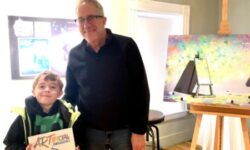[ccfic caption-text format="plaintext"]
By Katrina Margolis
Hometown Weekly Reporter
Harold Haliday Costain was known as one of the last great glamour photographers. Prominent during the late 19th century, Costain’s career spanned from Naval photography to cinema to advertisements. The Zullo Gallery is currently displaying his work, the opening reception for which was on May 19. Costain’s only daughter, Allison Haliday Costain, lives in Millis and was in attendance. Surrounded by Costain’s incredible work, she spoke about her father, their relationship, and his illustrious career.
Costain was the son of two artistic parents and spent the majority of his life in Scarsdale, New York. In 1913 he studied at the Art Students’ League in New York, where he met illustrator Norman Rockwell. Originally, Costain was an illustrating student as well. By 1915, however, he had joined the musician’s union, where he remained a lifelong member. “His career began during his brief time in the US Navy, where he was the unofficial photographer on the USS Leviathan during World War I,” his daughter, Allison, said. “In the Navy, he befriended G.J. Bagley, the inventor of the first amateur motion picture camera.” Through Bagley, Costain got his first film industry job with McMannis Motion Picture Productions, out of Jacksonville, Florida. Not only was he involved with filming, but also scriptwriting, set designing, and acting as well.
When studios began to move to California, Costain knew he wanted to stay on the East Coast, where his life was. He then opened his own photography studio in Scarsdale in 1925. The same year, he married his wife, Maude Allison Price, who remained his business partner under her death in 1966. For the rest of his life, he flourished as a real estate and advertising photographer. “His talent lay in his carefully curated scenes within each photograph,” Allison said.
Costain’s career was at a time when photography was growing and expanding its uses, one of which was advertising. His unique eye and raw talent allowed him to excel in the field. His photos were published in Town and Country, Country Life, and House and Garden. In addition, color was in its infancy and Costain was one of the pioneers of color photography. He used what is known as the “tri-color Carbro” printing process, which consists of three different color negatives produced simultaneously. His method was his own and created perfect archival color images that have lasted long after his time.
His work, and his legacy, live on after his death, and will continue to live on far into the future.









